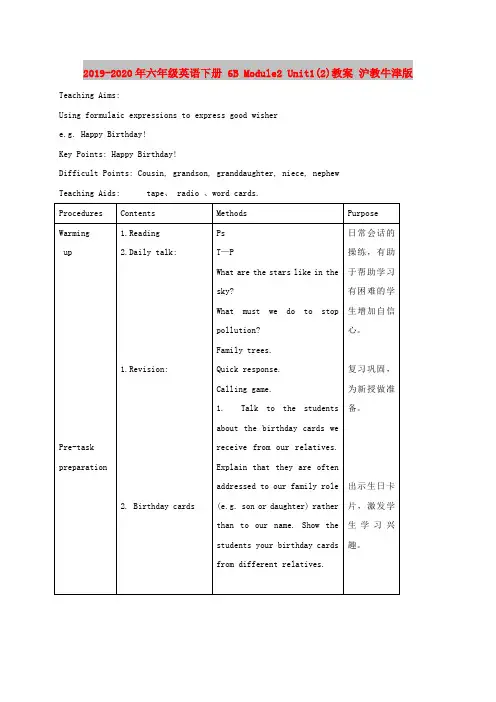(完整版)【沪教牛津版(三起)】六年级下册英语教案unit2Changesinourlives
- 格式:doc
- 大小:84.51 KB
- 文档页数:7
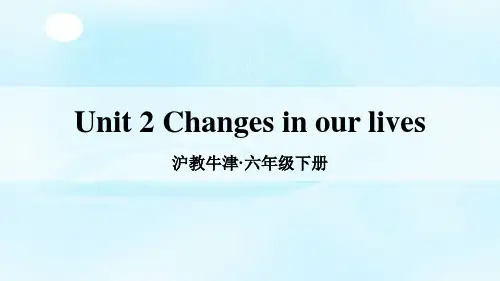
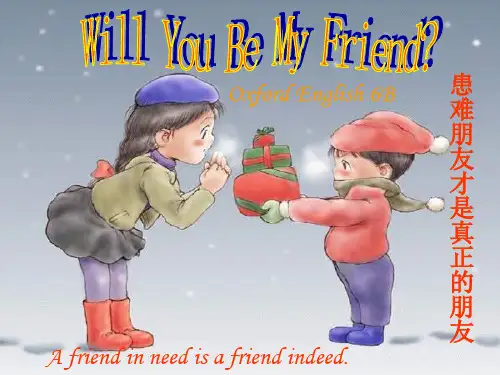
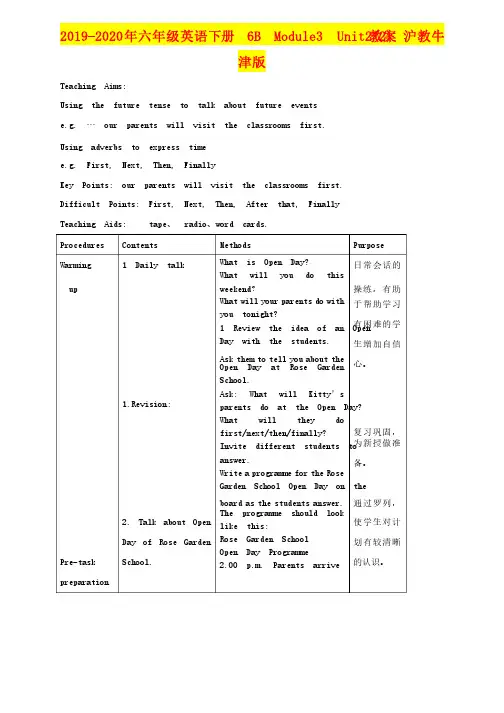
2019-2020年六年级英语下册 6B Module3 Unit2(2)教案 沪教牛津版Teaching Aims:Using the future tense to talk about future eventse.g. … our parents will visit the classrooms first.Using adverbs to express timee.g. First, Next, Then, FinallyKey Points: our parents will visit the classrooms first.Difficult Points: First, Next, Then, After that, FinallyTeaching Aids: tapetape、、 radio 、word cards. Procedures Contents Methods PurposeWarmingupPre-task preparation 1 Daily talk1.Revision:2. Talk about OpenDay of Rose GardenSchool.What is Open Day?What will you do thisweekendweekend??What will your parents do withyou tonight?1 Review the idea of an OpenDay with the students.Ask them to tell you about theOpen Day at Rose GardenSchool.Ask: What will Kitty’sparents do at the Open Day?What will they dofirst/next/then/finally?Invite different students toanswer.Write a programme for the RoseGarden School Open Day on theboard as the students answer.TheThe programmeprogrammeprogramme shouldshouldshould looklooklike this:Rose Garden SchoolOpen Day Programme2.00 p.m. Parents arrive日常会话的操练,有助于帮助学习有困难的学生增加自信心。
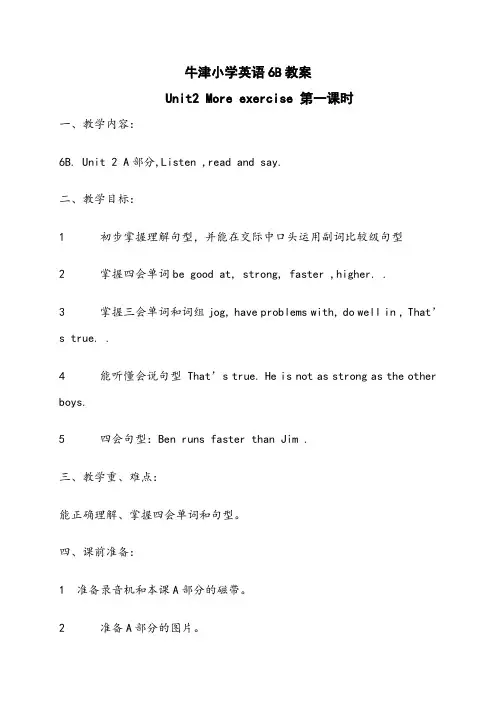
牛津小学英语6B教案Unit2 More exercise 第一课时一、教学内容:6B. Unit 2 A部分,Listen ,read and say.二、教学目标:1初步掌握理解句型,并能在交际中口头运用副词比较级句型2掌握四会单词be good at, strong, faster ,higher. .3掌握三会单词和词组jog, have problems with, do well in , That’s true. .4能听懂会说句型 That’s true. He is not as strong as the other boys.5四会句型:Ben runs faster than Jim .三、教学重、难点:能正确理解、掌握四会单词和句型。
四、课前准备:1准备录音机和本课A部分的磁带。
2准备A部分的图片。
3课前写好本课的课题6B. Unit 2A部分Look, read and say五、教学过程:A Sing a song. 跟录音机边听边表演唱英文歌曲HelloB Free talk. 师生交流T: Good morning, boys and girls.Ss:Good morning,T: Nice to see you again.Ss:Nice to see you, too.T: How old are you ?Ss: I’m 12years old.T:How old is he?Ss: He’s 11 years old ,too.T: Do you run fast?Doyou jump high?Do you swim fast?T: Who is taller ,you or you r brother?Which bag is heavier, yours or mine?C Presentation and drill新授和操练1教师通过刚才的师生问答引出句型I run faster than xxx。
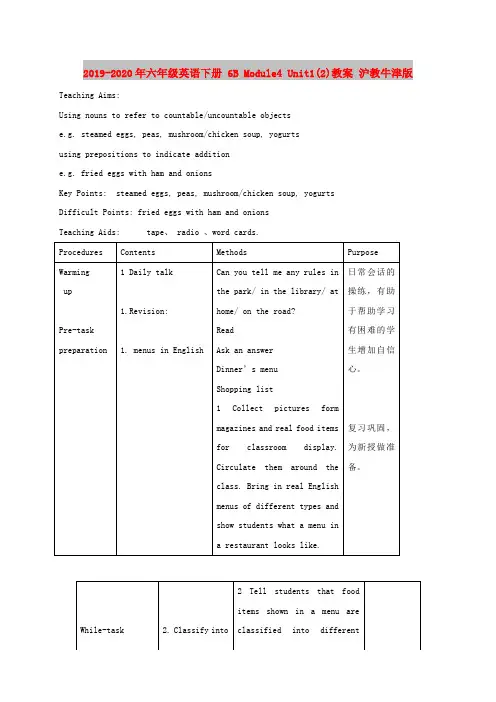
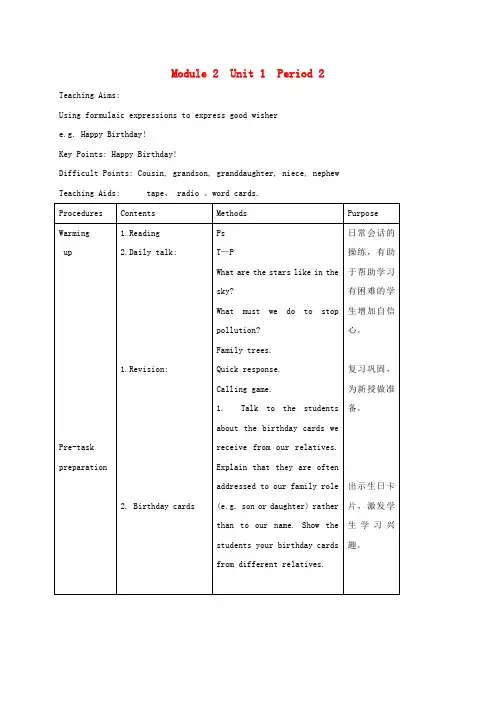
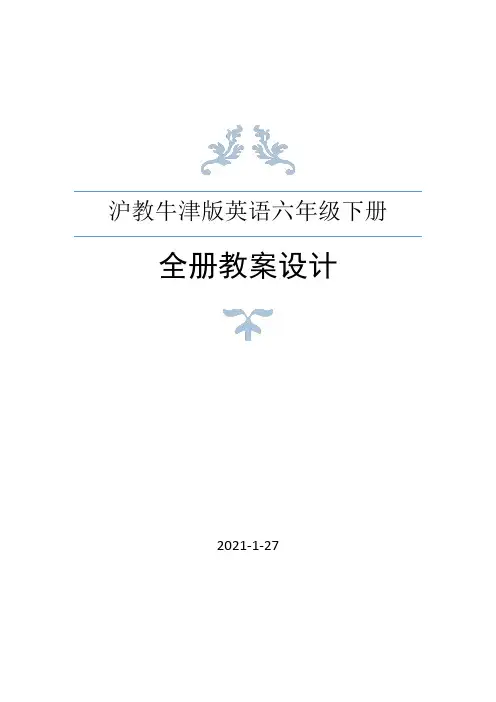
沪教牛津版英语六年级下册全册教案设计2021-1-27Module 1 Changes and differencesUnit 1 You and me◆教材分析This lesson about each other, high weight and after-school life topic, enhance the mutual exchange of students.◆教学目标【知识目标】Learning the core vocabulary of the unit.Through the investigation task, let the students use the language in the real situation.【能力目标】Through Look and read, it helps students to use the general present time and the. There be sentence patterns to introduce the living environment and its differences.【情感目标】Increase the mutual understanding and communication of the students.◆教学重难点【教学重点】Word: centimetre, kilogram, weigh, fan, go fishingSentence: I’m 150 centimetres tall.I usually play football after school.【教学难点】How exciting! That’s fantastic!◆课前准备Tape recorder, Multimedia◆教学过程Step 1. Free-talkWhat do you usually do after school?I usually read books.I usually sing songs.I usually...Step 2. Look and learnHow tall is Joe/George?Joe is 150 cm.George is 152 cm.cm = centimetre1 metre1 metre = 100 centimetresStep 3. Ask and answerA: How long is your...?B: My ... is ... centimetres long.Step 4. Look and learnGeorge is 40 kilograms.Joe is 47 kilograms.How much do you weigh?I weigh… kilograms.weighStep 5. Listen and sayWho is taller?… is taller.Joe is visiting his cousin George in the countryside.Joe: I weigh 47 kilograms. How much do you weigh, George?George: I weigh 40 kilograms.Joe: I’m 150 centimetres tall. How tall are you?George: I’m 152 centimetres tall.Joe: You’re taller. Do you do a lot of exercise?George: Yes. I usually play basketball and table tennis after school. Joe: I usually play football after school. I’m a football fan.George: Sometimes I go fishing with my grandpa.Joe: How exciting! I don’t go fishing often. There’s no river near my home.George: But you can go to museums. That’s fantastic!Step 6. Ask and answerWhat do you always/usually/often / sometimes do after school?I ...Step 7. Think and sayThat's fantastic! So cool!How exciting! How amazing!How nice! Wonderful!That's great!Step 8. Look and readWho lives in the countryside?What do people do in a theatre?theatreStep 9. Read and completeThere are a lot of __________ and _____ in the city.There are a lot of _____ and _________ too.There are a lot of ______ with garden in the countryside.There are ____, _____, _____and _____.Step 10. Read and answer1. How do people go to work in the city?People go to work by ca r, bus or underground.2. What do they do at the weekend?At the weekend, some people enjoy themselves at the cinema or theatre. Some people visit museums or parks.3. How is the air in the countryside?The air is fresh.4. What do people do in the countryside?People here like to walk or ride their bikes. Farmers plant crops in spring. Then in autumn, they get the crops.There are ... in the countryside.Step 11. Class debateWhich is a better place to live in, the city or the countryside?Step 12. Let’s guessYao Ming, a basketball playerHeight: ( ) 215cm ( √) 226cm ( ) 229cmWeight: ( ) 123kg ( √) 140kg ( ) 135kgHobbies: ( ) write books ( ) play the piano( ) do exercise (√) play basketballStep 13. Do a interviewHow tall are you?I’m 165 centimetres tall.How much do you weigh?I’m weigh 51 kilograms.What do you do every?I do exercise every day.Do you live in the city or in the countryside?I live in the city.Step 14. Free talkDo you like city or countryside? Why?Step 15. Learn the sounds/ei/table make rain play/ai/Ice fire cry night tie heightStep 16. HomeworkRead the text aloud according to the correct pronunciation and intonation.Module 1 Changes and differencesUnit 2 Changes in our lives◆教材分析Through the story of the happy farmer couple, the student's reading ability is promoted and the students are helped to understand the truth in the story.◆教学目标【知识目标】Learn new words through Look and learn and review the words that have previously been learned to represent a variety of professions.【能力目标】The short passage of Listen and say reviews the general past and the general present, and compares the difference between the present and the past.【情感目标】Understand the truth of this story.◆教学重难点【教学重点】Vocabulary: life, writer, street cleaner, drive, by hand, right away, in a short time.【教学难点】Works and expressions for everyday use:I wish you a happy life.◆课前准备Tape recorder, Multimedia◆教学过程Step 1.Free-talkIn the pastNowStep 2. Look and l earnWriterphotographerstreet cleanerfilmdigital cameraStep 3. Listen and followMs Wen is a writer.In the past, she used a pen and paper to write her books.Now she uses a computer.Mrs Hong is a farmer.In the past, she got her crops in by hand.Now she uses a machine.Mr Zhang is a photographer.In the past, he used film to take photos.Now he uses a digital camera. He can see his photos right away.Mr Yang is a street cleaner.In the past, he swept the streets with a broom.Now he drives a street sweeper. It can clean the streets in a short time. Step 4. Role-playThe students play the role.Step 5. Learn the sounds/əu/o, o-e, ow/au/ou, owStep 6. Try to read/əu/told smoke row/au/house towerStep 7. Read a story1. Where did Fred and his wife live?They lived in a small, old house.2. Who visited them? What did she say?A fairy. She said she could give Fred three wishes.3. What did Fred and his wife wish for?They did not make a wish.4. What did the fairy wish them?She wished them a happy life.Step 8. HomeworkWrite all the main occupation and follow the noun sentence make a sentence.Module 1 Changes and differencesUnit 3 Our school in the future◆教材分析The undergraduate through the Do a survey task, further consolidate the use of the general.◆教学目标【知识目标】Review the verb phrases through Look and learn.【能力目标】Through the writing task of Think and write, it helps students to consolidate the ability to use the written expression in general future.【情感目标】It is the students who learn to look forward to their future life.◆教学重难点【教学重点】Vocabulary: mountain, even, spaceSentence pattern review:In the future, schools will be different.【教学难点】The writing and application of sentences in the future.◆课前准备Tape recorder, Multimedia◆教学过程Step 1. Think and sayMy school in the pastIn the past, our school was...There was/were...There wasn’t/weren’t...Students...My school nowNow, my school is...There is/are...What did Ms Guo ask the children to do?Step 2. Think and answerWhat’s a time box?What would you like to put into a time box?Step 3.Look and learnThe simple future tensewillbe going towill not/won’tbe not going toThe simple future tensetomorrownext Monday/week/...in the futurein the futurethis evening/Sunday/...will / won’tbe going to/be not going toWhere would you go for a picnic?What would you take with you for a picnic?Who do you want to have a picnic with?What do you need to grow a plant?soila shovelStep 4. Read and writeOn sunny days, I like to have a picnic with my family. We always brings a lot of food and go to the same park. But in the future, I thin k picnics will be different. First, you will get information on the computer. You will know the best place to have a picnic.When you get to the place, you can choose the food online and the restaurant will send you the food. Wouldn’t that be interesting?Step 5. Read aloudStudents will have a picnic every month.Students will study online at home.Students will grow a lot of plants in the garden.Students will not carry any books.All their books will be on a small computer.I will be the head teacher.Step 6. Think and sayStudents will...Students will not...I will be...Step 7. Guess and saySchools of the future.Step 8. Think and sayWhere will schools be?They will be under the sea, on high mountains and even in space.How do you find books now?How will you find books in the future?Robots will help us find books in the library.Step 9. Discuss and shareWhat else can robots do?Step 10. Read aloudRobots will help us find books in the library.They will also do other things in schools.Step 11. Read and completeWe use _____ in our lessons now.In the future, we will use _________ in all our lessons.Step 12. Think and sayWhat will you do with computers in the future?What will teachers be like in the future?They will be...Step 13. Class debateRules:1. Choose Group A or Group B.A: Computers will replace teachers in schools.B: Computers will not replace teachers in schools.2. Present your ideas one by one.3. Each one can present for 1 minute.Step 14. Think and writeIn the future, schools will be different.Step 15. Read and thinkLast week,I flew a kite in the park.I fly a kite in the park every weekend.Next week,I will fly a kite in the park.Step 16. Look and sayLastEveryNestStep 17. HomeworkComplete the letter and read it aloud.Module 2 Work and playUnit 4 Art◆教材分析Through the writing activities of Think and write, help students to further consolidate and use the core sentences; one of their favorite paintings.◆教学目标【知识目标】Look and teach helps students to learn new words and review similar words.【能力目标】By reading the story of Da Vinci painting, helps students to review the past, grasp the language of daily usage, and experience the story behind the truth.【情感目标】Help students to practice core sentence patterns and guide students to express the reasons for what they like.◆教学重难点【教学重点】Understand Da Vinci and his masterpiece Mona Lisa.【教学难点】Know more famous paintings and painters.◆课前准备Tape recorder, Multimedia◆教学过程Step 1. Think and saysubjectsChineseArtPEScienceEnglishMusicMathsStep 2. Look and guessThe students are going to an art museum tomorrow.Step 3. Ask and answerWhat can we see in an art museum?art museumsculpturepaintingStep 4. Read aloudThe students are going to an art museum tomorrow. Miss Wang is telling them about some paintings.The Browns __________ the park this Sunday.are going toThe Chens __________________ this summer holiday.are going to the beachMy mum _______________ tomorrow.are going to the beachStep 5. Ask and answerWhere are you going this weekend/next month …?I’m going to …Step 6. Think and change1. We will go to Beijing this summer holiday.We are going to Beijing this summer holiday.2. They are going to the park next Sunday.They will go to the park next Sunday.Step 7. Listen and answer1. Which painting does Kitty like? Why?She likes the one on the left because she likes the colours.2. What do you know about the paintings on the left?The painting on the left is an oil painting.It’s colourful.3. What do you know about the painting on the right?It’s a Chinese ink painting. It’s usually in black and white.4. Which painting does Joe like? Why?He likes the one on the right because he likes horses.on the lefton the rightStep 8. Ask and answerLook. Which bear do you like? Why?I like the one … because …Which story do you like? Why?I like the one … because …Which house do you like? Why?I like the one … because …Step 10. Look and sayWhat kind of paintings are they?How do you know?Which painting do you like? Why?Can you draw well?Step 11. Look and guessWhat was Little Leo doing?He was showing his picture to his friends. What did his friends think of his picture? They thought it was wonderful.Step 12. Read and answerWhat did the teacher ask Little Leo to draw?The teacher asked him to draw an egg.Did Little Leo think it was difficult?No. He thought it was easy.Step 13. Look and learnhappy unhappyusual unusualhealthy unhealthylucky unluckyStep 13. Read a storyLittle Leo worked very hard and became a great artist.Step 14. Think and discuss1. If you were Little Leo, would you listen to the teacher and draw an egg again and again?2. Does your teacher ask you to do something boring again and again?3. What do you learn from the story?Perseverance leads to success!Step 15. Retell the storyStep 16. HomeworkMaster the sentence patterns in this class.Module 2 Work and playUnit 5 Crafts◆教材分析Through the Listen and say situational dialogue, help students to review the Wh-questions and the present time, talk about hand making.◆教学目标【知识目标】Through Look and learn, students can help students learn new words and review similar words.【能力目标】Through the language output column of Make and say, the topic language is consolidated.【情感目标】Learn how to sum up the story and cultivate the spirit of thinking.◆教学重难点【教学重点】To cultivate students’ reading ability through the story “Luban and the saw”.【教学难点】Learning to describe the handmade process.◆课前准备Tape recorder, Multimedia◆教学过程Step 1. Look and learnWhat do you need in a crafts class?Glue.What do you need in a crafts class?Scissors.What do you need in a crafts class?Tape.Step 2. Let’s learnIt’s raining outside.What do you need?Who are they?What are they doing?Step 3. Listen and followThe students want to make presents for their families and friends.Ms Guo is helping them.Ms Guo: What do you want to make, Jill? What do you need?Jill: I want to make a crown. I need a pair of scissors.Ms Guo: That sounds nice. Who is it for?Jill: It’s for my little cousin. She wants to be a princess.Ms Guo: What about you, Peter? What are you making?Peter: I’m making a toy plane for my brother. He likes playing with toy planes.Ms Guo: That’s good. What are you making, Joe and Alice?Joe & Alice: We’re making a model house. It’s for Kitty. Her birthday is coming. We don’t have any tape. Can you give us some, please?Ms Guo: Sure!Step 4. Role-playLevel1:分角色朗读对话,注意模仿语音语调。
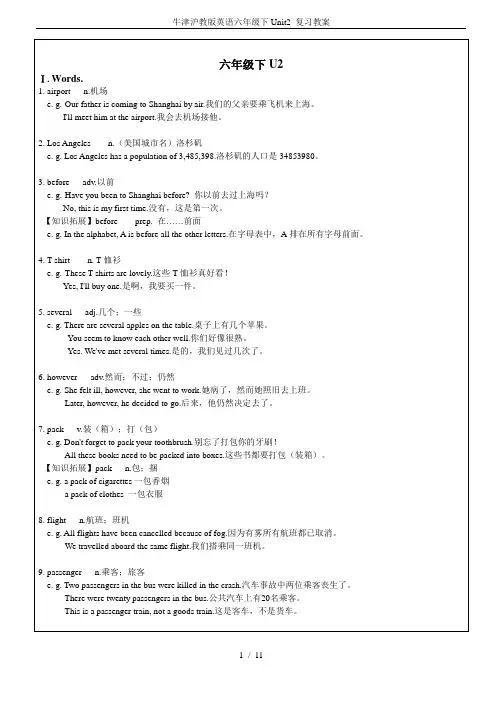
10. departure n.离开;出发e. g. departure time出发时间Mary, can you arrive at the railway station one hour before the departure time?玛丽,你能在列车出发前一小时到达火车站吗?【知识拓展】depart v.离开,起程e. g. We departed for London at 10 a.m.我们上午10点动身去伦敦。
11. worry v.担心e. g. -Jane hasn't come home yet.简还没回家。
-Don't worry. She'll be back soon.别担心,她很快就回来了。
【知识拓展】worried adj.焦虑的e. g. -The old man looks worried.那个老人看起来很着急。
-Let's ask if he needs help.咱们去问问他是否需要帮助。
12. London n.伦敦e. g. -London is the capital of the United Kingdom.伦敦是英国的首都。
-How many people live in London? 伦敦有多少人居住?-About seven million.大约700万。
【百科小贴士】伦敦建都于11世纪,至今已经有九百多年的历史。
伦敦位于泰晤士河下游两岸。
大英博物馆、伦敦塔、白金汉宫、大本钟均为著名的旅游景点。
13. note n.注释;提醒;注意事项e. g. On the board beside the river there is a note: Don't swim in the river. It is dangerous!河边的木板上有句提示语:不要在河里游泳。
危险!They are reading an edition of Shakespeare with student's notes.他们正在阅读一套附有学生注解的莎士比亚作品集。
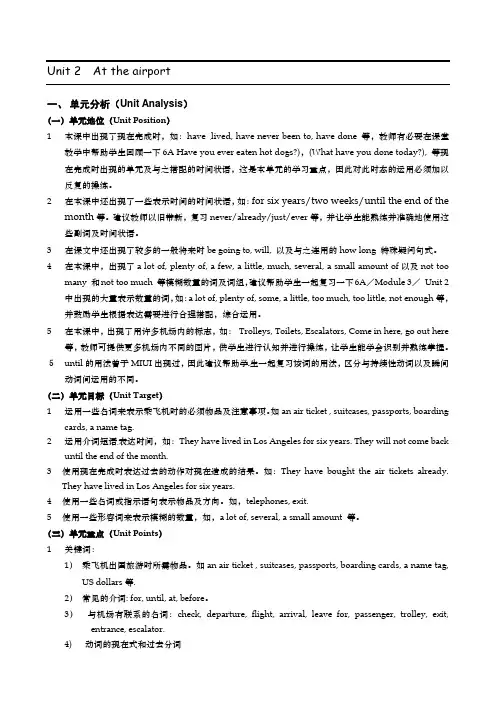
Unit 2 At the airport一、单元分析(Unit Analysis)(一)单元地位(Unit Position)1 本课中出现了现在完成时,如:have lived, have never been to, have done 等,教师有必要在课堂教学中帮助学生回顾一下6A Have you ever eaten hot dogs?),(What have you done today?), 等现在完成时出现的单元及与之搭配的时间状语,这是本单元的学习重点,因此对此时态的运用必须加以反复的操练。
2在本课中还出现了一些表示时间的时间状语,如:for six years/two weeks/until the end of the month等。
建议教师以旧带新,复习never/already/just/ever等,并让学生能熟练并准确地使用这些副词及时间状语。
3在课文中还出现了较多的一般将来时be going to, will, 以及与之连用的how long 特殊疑问句式。
4在本课中,出现了a lot of, plenty of, a few, a little, much, several, a small amount of以及not too many 和not too much 等模糊数量的词及词组,建议帮助学生一起复习一下6A/Module 3/Unit 2中出现的大量表示数量的词,如:a lot of, plenty of, some, a little, too much, too little, not enough等,并鼓励学生根据表达需要进行合理搭配,综合运用。
5在本课中,出现了用许多机场内的标志,如:Trolleys, Toilets, Escalators, Come in here, go out here 等,教师可提供更多机场内不同的图片,供学生进行认知并进行操练,让学生能学会识别并熟练掌握。
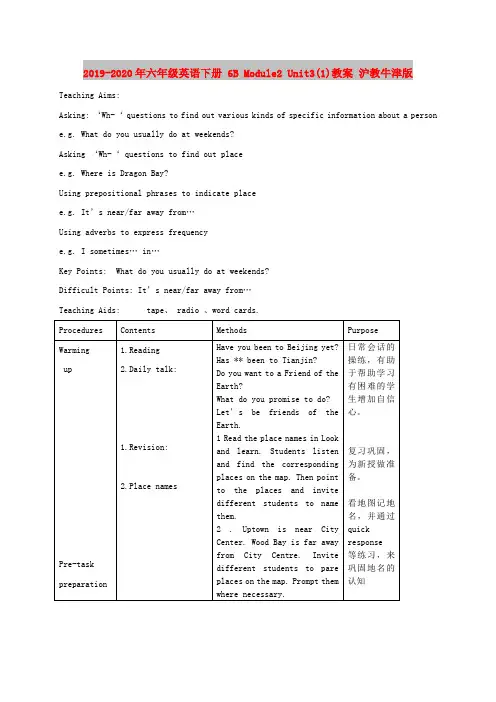
2019-2020年六年级英语下册 6B Module2 Unit3(1)教案沪教牛津版Teaching Aims:Asking: ‘Wh-‘ questions to find out various kinds of specific information about a person e.g. What do you usually do at weekends?Asking ‘Wh-‘ questions to find out placee.g. Where is Dragon Bay?Using prepositional phrases to indicate placee.g. It’s near/far away from…Using adverbs to express frequencye.g. I sometimes… in…Key Points: What do you usually do at weekends?Difficult Points: It’s near/far away from…Teaching Aids: tape、 radio 、word cards.附送:2019-2020年六年级英语下册 6B Module2 Unit3(2)教案沪教牛津版Teaching Aims:Using the present perfect tense to relate past events to the presente.g. I’ve been to Seaview Town Lucky Island.Using the present continuous tense to describe an action-taking place at the time of speaking e.g. We are shopping in the market.Using prepositions to indicate placee.g. on Lucky Island/in Garden CityUsing proper nouns to refer to placese.g. I’ve been to Stone Bay.Key Points: I’ve been to Seaview Town Lucky Island.Difficult Points: We are shopping in the market. This is a photograph of…Teaching Aids: tape、 radio 、word cards.小学教育资料好好学习,天天向上!第5 页共5 页。
